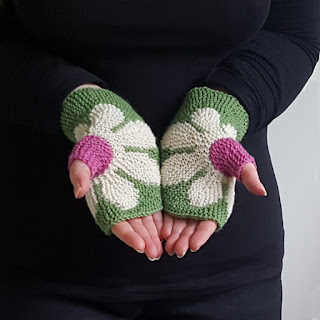Fingerless gloves are my favorite accessory – there are so many varieties and ways to construct them.
The ones here are knitted flat and in garter stitch with a wave pattern. One edge of the flat row is the thumb around which the mitt shaped in short rows. It starts with a provisional cast on and ends with a row of grafting in garter stitch. The wavy patternis created with increases and decreases.
This is NOT a beginner pattern.
The knitting pattern is available via
The pattern PDF is 12 pages long contains
- written row-by-row instructions for knitting a mitt in one size (slight adjustments can be made by using a different needle size)– including six photos of the different stages
- a full pattern chart
- short photo tutorials for the following techniques:
- provisional CO with a crochet hook and how to undo it
- grafting in garter stitch
- short rows with wrap and turn and picking up the wraps
- With 2.5 mm needles 28 ridges (56 garter stitch rows) gave me 10 cm in height and 25 sts gave 10 cm in width (with an unblocked swatch, since I didn't block the mitts). The finished piece knitted with 2.5 mm needles is about 19 cm high (at it's highest point) and about 17 cm in diameter (without just below the thumb).
- With 3 mm needles 26 ridges (53 garter stitch rows) gave me 10 cm in height and 23 sts gave 10 cm in width (also with unblocked swatch). The finished piece measures about 20 cm in height and about 19 cm in diameter (just below the thumb).
- a total of about 35 to 40 grams of fingering weight yarn - I used
- Zwerger Opal Fairytale (colorway 9794 Knusperhaus) for nearly rainbow colored mitts in the title photo (link to the yarn's Ravelry page)
- Vendita sock yarn (colorway 12) for the blue green pair (link to the yarn's Ravelry page)
- Zwerger Opal 4-ply (colourway 9692, "Ice Cream / Sahnequark") for the grey pair (link to the yarn's Ravelry page)
- 2.5 mm or 3 mm knitting needles (or another needle that gives you the gauge) – straight or circulars
- scrap yarn and a crochet hook (about 3mm) for the provisional CO
- 10 stitch markers – 4 of which removable
- a tapestry needles for grafting and to weave in ends
 |
| One mitt finished - one mitt needs to be sewn up |






















